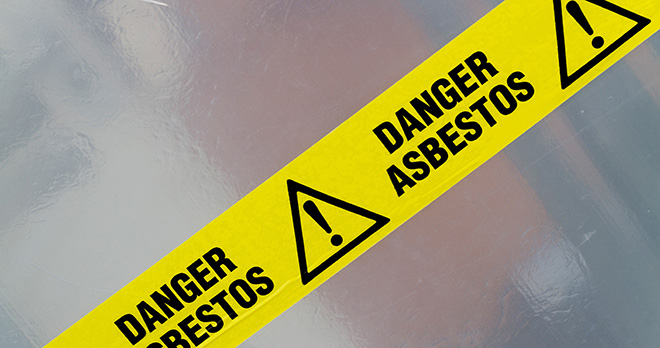Asbestos in public buildings – where are we now?

The problem
You’d be forgiven for thinking that the threat posed by asbestos is a thing of the past in the UK. After all, the use, supply and import of asbestos was banned 25 years ago. However, this misconception assumes that asbestos in buildings built before this time has been entirely removed. Alarmingly, this is not the case.
Some sources estimate that over 1.5 million buildings in the UK contain asbestos, with a large proportion – as many as 400,000, according to the Health and Safety Executive – being public buildings, including schools, hospitals, office spaces or community centres. The asbestos might be present in the form of pipe insulation, internal walls, ceiling tiles or flooring. Whilst it might be considered a low risk to health if properly managed, the fact is that incidents of asbestos exposure in these buildings are still happening today. This might be due to ignorance of the dangers of asbestos and/or the legal duties imposed on the owners of these buildings or knowingly cutting corners to save costs. These buildings are also degrading over time meaning that there is a real risk of asbestos dust being released simply through general wear and tear.
More than 5,000 people die from asbestos-related diseases every year in the UK. Can we reasonably hope to see an end to these deaths whilst our public buildings contain asbestos on such a large scale?
We have brought many successful claims against local authorities and the Government for former teachers, nurses and students who have contracted mesothelioma from asbestos exposure in a school or hospital setting. My view is that the risk of exposure to asbestos remains if action is not taken to tackle the problem of asbestos in public buildings by having it removed once and for all.
Government’s response to the Work and Pensions Committee report, April 2022
In April 2022, the Work and Pensions Committee published their report, “The Health and Safety Executive’s Approach to Asbestos Management” within which it recommended that a 40-year target be set for the removal of all asbestos from public buildings. In the report, the Chair, Rt Hon Sir Stephen Timms MP, described asbestos as “the great workplace tragedy of our time”.
Unfortunately, the Government’s response to the above recommendation was to accept the Health & Safety Executive’s evidence that the Control of Asbestos Regulations 2012 effectively managed the risks of asbestos exposure and will eventually lead to the elimination of asbestos from the built environment without the need for a target deadline. It added that it “could only advocate a proactive course of action in this area if there is compelling evidence that the undoubted increase in exposure to asbestos workers that will result from active removal… is justified in terms of reducing risk of exposure to building users” adding that “at present, this evidence is not there.” The Government commented further that a fixed deadline for the removal of asbestos in public buildings would cause significant disruption to their use and risk poor removal and disposal practices.
Whilst there will be some unavoidable disruption of the use of public buildings if the Committee’s recommendations are implemented, that does not necessarily mean the risk of asbestos exposure to those who would carry out the asbestos removal work outweighs the present risk to the public. Unless there is a dramatic watering down of asbestos removal legislation, the asbestos removal work will be undertaken by specialists taking all the proper precautions, therefore with very limited risk to their health and that of the public. Unfortunately, it cannot be said that the same precautions are being taken by the unassuming public who use these buildings day in, day out – especially as asbestos is not always being properly managed, and the risks of asbestos exposure not always being properly controlled (whether knowingly or not) in public buildings despite the regulations that are in force. This is surely putting the public at greater risk right now compared to any small potential risk to those removing the asbestos.
Furthermore, the Government did not give any reason as to why it believes a phased asbestos removal plan (over a prolonged period of 40 years) will result in an increase of poor removal and disposal practices. Indeed, the Government appeared to have overlooked the comparable risk of shortcuts being taken and accidents happening when it comes to ongoing asbestos management for as long as the asbestos remains present.
Mesothelioma UK’s “Don’t Let the Dust Settle” campaign, April 2023
The Government’s rejection of the Committee’s proposals was certainly a blow to the campaign to see all asbestos removed from public buildings, but momentum gathered regardless after 3 April 2023 when Mesothelioma UK launched its “Don’t Let the Dust Settle: Calling Time on Asbestos” campaign.
Mesothelioma UK is calling for a central register detailing where asbestos is and its condition and is asking the Government to set a timeframe for the safe removal of asbestos from public buildings, prioritising schools and hospitals over the next 40 years.
The Sunday Times launched their “Act Now on Asbestos” campaign in July 2023. Indeed, several charities, MPs, asbestos removal firms and law firms, including RWK Goodman, have helped this campaign build momentum like never before over the past few months.
A parliamentary petition calling for the Government to commit to the recommendations of the Work and Pensions Committee report of 2022 was opened last year to tie in with the above campaigns and attracted over 10,000 signatures, prompting a response from the Government.
The Government commented that it needs “… clear evidence to demonstrate how responding to the two recommendations would improve health outcomes”, adding that “we will continue to consider how we can improve the system to minimise the risk of exposure to asbestos.” The Government voiced the same argument made in its direct response to the Work and Pensions Committee report (above) regarding the current effectiveness of the Control of Asbestos Regulations 2012 in providing a “comprehensive plan to manage asbestos risk.”
I would argue that the Government is, again, missing the point here. Yes, the Control of Asbestos Regulations 2012 do outline a comprehensive asbestos management plan, but are they always being followed? Is, for example, information about the location, condition and type of asbestos in buildings always made available to anyone liable to disturb it or are corners being cut whether inadvertently or to save costs? Moreover, can we safely assume that all users of public buildings are alive to the true dangers of asbestos? Do they even know that asbestos might be around them in these buildings? Would they know not to disturb it? Even if they do, there is the ongoing risk posed from the daily wear and tear of asbestos in the buildings around them. Not to mention that asbestos was often used in conjunction with RAAC, much of which is now well beyond its intended lifespan.
Unfortunately, it looks as though this debate will rumble on for some time to come with the apparent age-old battle between financial resources and people’s health; a battle that for decades has unfortunately always tended to weigh in favour of the former.
However, is it right to assume that implementing the Committee’s recommendations will hit the public purse harder than continuing the status quo?
Mesothelioma UK’s “Cleaning the Air” Report, December 2023
Mesothelioma UK’s “Cleaning the Air” report, published in December 2023, performs a costs/benefits analysis of the removal of asbestos from UK schools and hospitals. It compares the costs involved with the current rebuilding programme for schools and hospitals (resulting in the complete removal of asbestos from these buildings) with the costs involved with a proposed “Rapid Removal Programme” of removing asbestos over a 10-year period. The findings are that, over a 50-year time period, the Rapid Removal Programme would save the UK economy around £11.6 billion in reduced economic and social costs compared to the current removal programme. It estimated that savings to public finances would be in the sum of £3.6 billion.
The question is whether the Government will invest now to solve the problem of asbestos in public buildings to save significant additional costs in years to come. My hope is that they will do the right thing and that the tide will finally turn to prevent yet more lives being lost – completely avoidably – to asbestos-related illness.
Contact our mesothelioma and asbestos claims specialists today.
Call now

